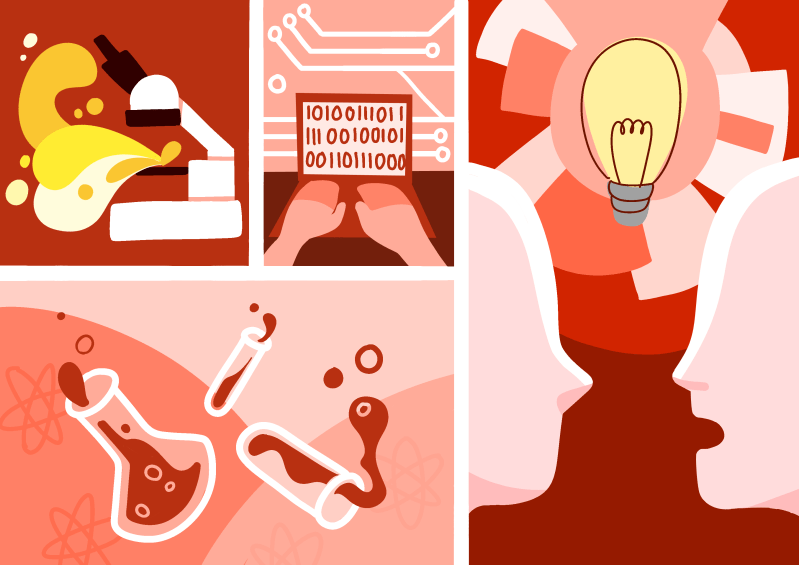The Daily’s academics desk gathers impactful research publications and developments at Stanford in the weekly research roundup.
Surgical successes powered by AR
A team of surgeons at Stanford Health Care recently performed a successful ablation — a surgical procedure to correct abnormal heart rhythms — using augmented reality (AR) technology from the Apple Vision Pro.
Donning a Vision Pro headset, cardiac electrophysiologist Alexander Perino could view up to eight simultaneous displays that meshed with the operating room. The headset allowed him to view data such as X-rays, anatomical images of the heart and vital signs in real time. It follows Perino’s gaze and allows him to zoom in on specific data he needs.
“We hope that this first demonstration will help establish the tool as something surgeons and proceduralists can use to reduce barriers to quickly and easily review and manipulate intraprocedural data, increasing efficiency and clinician enjoyment,” Perino told Stanford Medicine.
Perino and his team said they look forward to continuing exploring the use of augmented reality in the operating room, as well as in educational and training environments.
Artificial intelligence identifies gentrification
Researchers built an artificial intelligence (AI) model that detects early signs of urban gentrification by tracking changes in image data collected from Google Street View.
The model, built by assistant sociology professor Jackelyn Hwang ’07 and third-year civil engineering Ph.D. student Tianyuan Huang, identified gentrification with 74% accuracy when compared to relevant studies using U.S. census data.
Gentrification, which occurs when higher-income groups move into low-income neighborhoods, often drives up housing prices in certain neighborhoods in high-density urban areas.
Hwang and Huang trained the model on construction and business data from Oakland, Denver and Seattle, three high-density cities. The pair also streamlined their model to predict only when construction occurs — a strong indicator of the phenomenon — with 90% accuracy.
Hwang said AI gentrification detection systems can produce effective recommendations for solutions to urban housing challenges.
“Being able to measure patterns of reinvestment in places that are gentrifying as well as disinvestment in places that don’t gentrify can help us think about allocating resources in ways that would better help vulnerable communities,” she said in an article written for Stanford’s Human-Centered Artificial Intelligence Institute.
Generative AI to self-driving spacecraft
The Stanford Center for Aerospace Autonomy Research (CAESAR) developed an artificial intelligence (AI) neural network that can plan and calculate the movement of multiple docking spacecraft. The technology, named Autonomous Rendezvous Transformer (ART), could pave the way for fully autonomous spacecraft in the future.
Researchers presented the neural network at the Institute of Electrical and Electronics Engineers Conference, which was hosted from Mar. 2 to Mar. 9.
The AI model uses machine learning to rapidly generate possible trajectories for spacecraft. Through this process, trajectory projections can become integrated directly into navigation systems on board and computed at faster speeds than previously possible. They no longer require sending data to ground stations for calculations.
“AI is helping us manage the complexity and delivering the accuracy needed to ensure mission safety, in a computationally efficient way,” said Simone D’Amico, associate professor of aeronautics and astronautics and co-director of CAESAR, in an interview with Stanford News.
Though ART is not currently implementable on spacecraft, CAESAR researchers anticipate continued development and rigorous testing of the technology that will allow a new generation of self-driving spacecraft to take flight.
Wildfire mitigation strategies
Researchers at Stanford’s Jasper Ridge Biological Preserve are taking advantage of the Bay Area’s wet weather to prepare for the upcoming fire season. The recent rain allowed scientists to conduct low-intensity fires that burn debris and prevent dangerous wildfires.
According to the researchers, these types of management fires can reduce the chance of a wildfire occurring by 60%. A safe environment for controlled fires of flammable material allows scientists to take wildfire fuel essentially out of the equation, critically lowering the likelihood of a disastrous wildfire from breaking out.
“Fuel reduction, wildfire management [and] risk mitigation is a community-level effort,” Jasper Ridge staff scientist Sheena Sidhu told ABC7 News.
The researchers, along with students, plan to study how different intensities of fires affect the environment using the controlled setting of a fresh rainy season. They will observe the outcomes of controlled fires and predict what will happen in the event of a wildfire.
